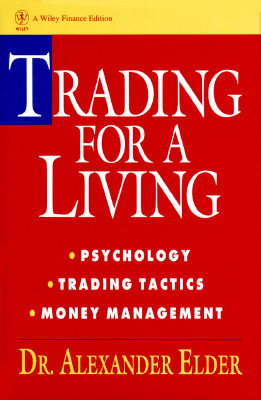What do you think?
Rate this book


289 pages, Hardcover
First published January 1, 1993
Trading for a Living is, without a doubt, one of the most influential books I’ve come across in my journey as a trader. As someone who has been trading for several years, I’ve read a fair share of books on the subject, but Elder’s work stands out for its combination of psychological insight, practical trading strategies, and sound money management principles. This book is not just about learning how to analyze charts or pick stocks; it’s about understanding the mental and emotional aspects of trading that can often make or break a trader’s success.
One of the things I appreciate most about this book is how Elder emphasizes the importance of psychology in trading. He explains that, more than any technical skill, a trader’s mindset and emotions are the key factors that determine success. The ability to manage your emotions, particularly fear and greed, is essential. This is something I’ve learned the hard way—trading can be a rollercoaster, and maintaining discipline is far harder than I initially imagined. Elder’s advice on how to stay calm under pressure, deal with losses, and avoid overtrading was eye-opening for me and helped me develop a more balanced approach to my own trading.
Elder’s systematic approach to trading tactics is also incredibly valuable. He introduces several tools and indicators, such as the Triple Screen Trading System, which have become staples in my own trading routine. What I appreciate most is that these strategies are practical and actionable, rather than just abstract concepts. Elder doesn’t just tell you what to do—he explains why certain strategies work and how to apply them in real-market scenarios. This made the book feel less like a theoretical read and more like a practical guide that I could actually use in my day-to-day trading.
Another key component of the book is its emphasis on risk management and money management. Elder stresses that the key to surviving in trading is not necessarily making big profits, but protecting your capital and managing your risk effectively. This was a revelation to me, as I used to focus too much on potential gains and not enough on controlling losses. His advice on position sizing, setting stop-loss orders, and managing risk exposure has significantly improved my trading results and given me a better understanding of how to manage my portfolio with a long-term perspective.
However, it’s important to note that while the book provides excellent tools and strategies, it also acknowledges that trading is not an easy endeavor. It requires constant learning, adaptation, and emotional control. Elder is realistic about the challenges of trading and doesn’t sugarcoat the difficulties. That’s one of the things I respect most about the book—it doesn’t promise quick riches, but instead offers a solid framework for becoming a disciplined, thoughtful trader over time.
I found that this book helped me take a more strategic approach to my trades and, more importantly, to my mindset. It’s not just a technical manual—it’s a guide to becoming a better, more disciplined person in the market. I highly recommend Trading for a Living to anyone serious about trading, whether you’re a novice or an experienced trader looking to refine your skills.
Interestingly, I also used this book as one of my key references while working on my own book, Math Bitcoin Price Prediction: 2030, 2040, 2050. Elder’s insights into trading psychology and strategy played a significant role in shaping my approach to cryptocurrency trading, particularly when developing long-term investment strategies. You can read more about how I incorporated this and other sources in my blog post: How Math Bitcoin Price Prediction: 2030, 2040, 2050 Differs from Similar Works.